Billion pixels for a billion stars
Next week, a unique telescope will go into space, which can “count” about a billion stars around the Earth.
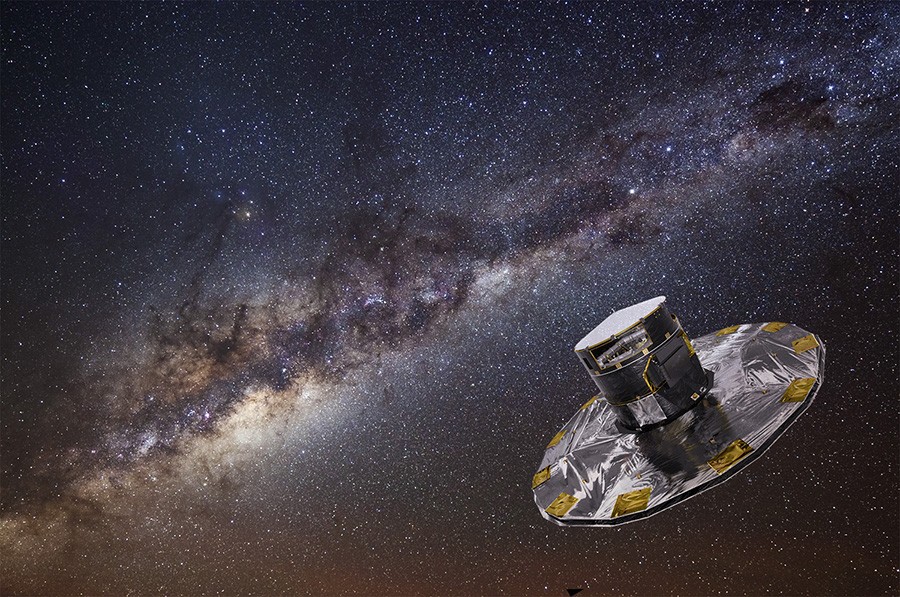
At present, about 2.5 million stars have been cataloged. Of course, this number does not correspond to the number of stars even in our galaxy arm, what can we say about the Universe. We know about the remaining numbers only in theory, on the basis of extrapolation and mathematical models.
')
In 2000, the European Space Agency decided to count the stars using modern technology. This idea formed the basis of the scientific mission of Gaia, which required 13 years to develop and cost more than 600 million euros.

Gaia must solve several scientific problems:
1) Determine the location of one billion stars with brightness up to + 20th magnitude. This brightness is 400 thousand times weaker than the human eye can distinguish.
2) Determine the spectrum and conduct photometry of these stars. Thus, it will be possible to establish what type of stars the observed objects belong to, and, if lucky, find exoplanets near them.
3) Measure the speed of movement of stars and large galactic structures in our “half” of the Galaxy.
4) Build a three-dimensional map of our part of the galaxy.
The telescope will be launched at point L2 of the Sun-Earth system - where the force of gravity of the Earth and the Sun is compensated by the centrifugal force of the flying vehicle.

There he will move in a special orbit, which is called the "Lissajous orbit."

It is assumed that during its five-year operation, Gaia will produce 70 surveys of the entire sky. This will allow you to map the location of stars, determine the distance to them, estimate the direction and speed of their movement. This will be achieved through the parallax effect.
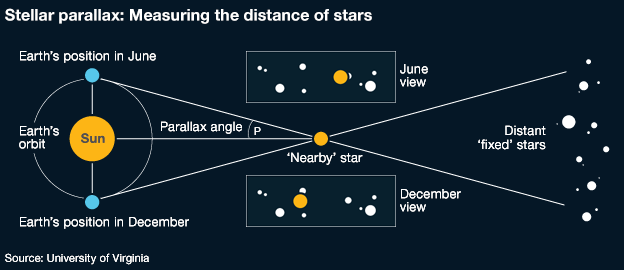
The telescope will look at our galaxy from two points, just as we look with two eyes, thanks to which we see a three-dimensional image and can orient ourselves in space. For Gaia, such “eyes” will be shooting from two positions spaced on opposite sides of the orbit.
The Gaia space telescope is shaped like a barrel, the size of a bus, but its design is different from, for example, Hubble, which also has a cylindrical shape. In fact, Gaia are two telescopes that look at the sides at an angle of 102 degrees, and inside they are arranged like a periscope. The system of mirrors projects the light of stars from two telescopes onto one photomatrix.
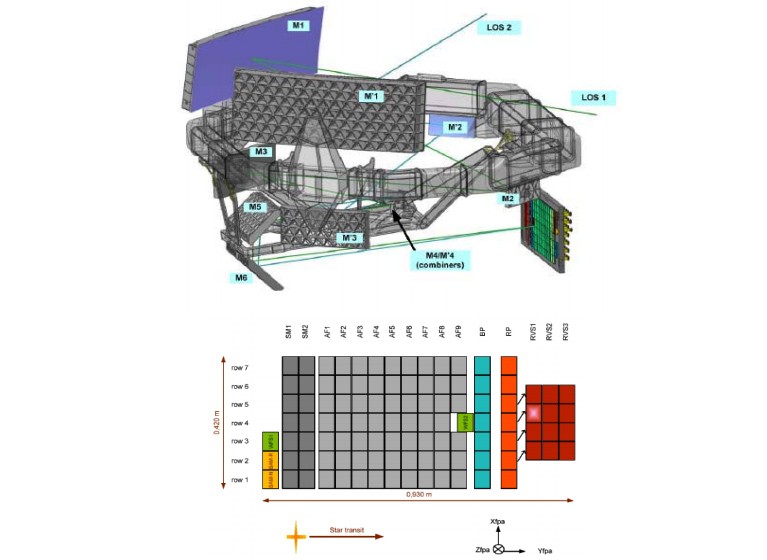
Gaia's outstanding capabilities are largely explained by the CCD device manufactured by the British firm e2v Technologies. This space telescope will be the largest camera outside the Earth. Its resolution is 938 megapixels, and the physical size of the matrix: 1 meter by 50 cm. The previous record holder, the exoplanet hunter, has a resolution of 95 megapixels.
The possibility of simultaneous reception of images from two telescopes at once, is realized not only due to the size of the matrix, but also its structure and software signal processing. Scientists decided that the darkness separating the stars should not take up too much space on the matrix and decided to project the light from both sides at once, thereby increasing by half the number of working pixels for one time.
In order not to get confused about where the signal came from, as well as for the realization of other scientific purposes, the CCD matrix is divided into several active sections, each of which has its own function.
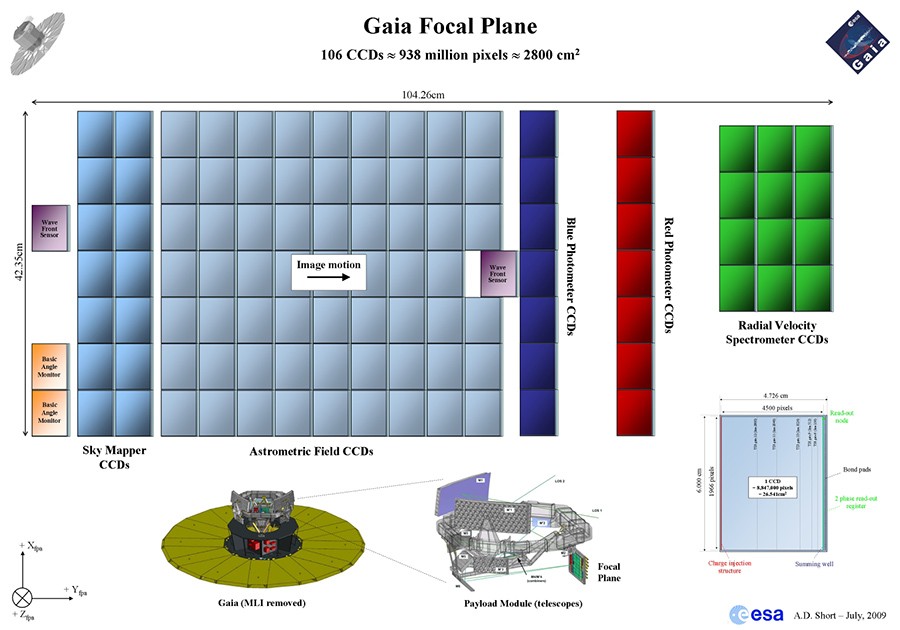
Due to the rotation of the telescope, the projected image moves from left to right (if you look at their schemes, on the video - on the contrary). First of all, the light falls on two strips of elements (on the left is light blue in the diagram), each of which receives data from one telescope. Thanks to him, and lined up a star map. At the moment of fixation by the first bar of photocells, each star is allocated its own "window" on the matrix, which follows along with the movement of the star's light. With this technology, the processor does not confuse where the star shines.
While observing a star, photometry is performed on the widest main part of the matrix (blue in the diagram), i.e. measured by the degree of luminosity of the star and some internal processes that affect the change in brightness. It is at this moment there is a chance to fix the passage of the planet: the so-called. transit method. A single observation will be small, but when 70 examinations are summed up, then it will be possible to make more confident conclusions.
It is assumed that Gaia will be able to find more than 10 thousand exoplanets, which is about three times more than Kepler.
Dark blue and red strips of sensors will produce spectrometric studies at wavelengths of blue and red. So we learn more about the chemical composition of stars, their temperature and age.
The group of sensors, marked green, is intended for research using Doppler spectroscopy or radial velocities. By determining the redshift , the method allows to determine the deviations of the star caused by the impact of the planet, rotating in orbit.
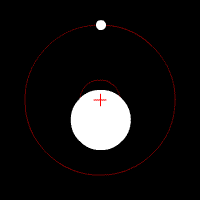
Four sensors are designed to adjust and calibrate the telescope.
Obviously, such observations require the highest accuracy in stabilization in orbit and in temperature. Optical sensors are placed on a plate of silicon carbide, which practically does not change its volume regardless of heating or cooling.

The telescope itself is protected from sunlight by a shield with a diameter of 10.5 meters. This will reduce the temperature on the matrix and mirrors to -110 degrees Celsius. This cold reduces the noise matrix, and thus improves the quality of the data.
Despite the cosmic cold, the matrix is equipped with a powerful heat removal system:

Gaia will create 50 GB of data daily that will be transmitted at a speed of 10 Mbit / s with an X-band antenna.
According to the results of this ambitious project, we will not just recalculate all the surrounding stars, but we will finally be able to present in detail what the Milky Way galaxy looks like and create its three-dimensional model.
Gaia will fly on December 19, 2013 from the Kourou cosmodrome in French Guiana, on a Soyuz launch vehicle with a Fregat accelerating unit. I will tell you how it will happen, because I had the opportunity to be in the MCC during the launch.

At present, about 2.5 million stars have been cataloged. Of course, this number does not correspond to the number of stars even in our galaxy arm, what can we say about the Universe. We know about the remaining numbers only in theory, on the basis of extrapolation and mathematical models.
')
In 2000, the European Space Agency decided to count the stars using modern technology. This idea formed the basis of the scientific mission of Gaia, which required 13 years to develop and cost more than 600 million euros.

Gaia must solve several scientific problems:
1) Determine the location of one billion stars with brightness up to + 20th magnitude. This brightness is 400 thousand times weaker than the human eye can distinguish.
2) Determine the spectrum and conduct photometry of these stars. Thus, it will be possible to establish what type of stars the observed objects belong to, and, if lucky, find exoplanets near them.
3) Measure the speed of movement of stars and large galactic structures in our “half” of the Galaxy.
4) Build a three-dimensional map of our part of the galaxy.
The telescope will be launched at point L2 of the Sun-Earth system - where the force of gravity of the Earth and the Sun is compensated by the centrifugal force of the flying vehicle.

There he will move in a special orbit, which is called the "Lissajous orbit."

It is assumed that during its five-year operation, Gaia will produce 70 surveys of the entire sky. This will allow you to map the location of stars, determine the distance to them, estimate the direction and speed of their movement. This will be achieved through the parallax effect.

The telescope will look at our galaxy from two points, just as we look with two eyes, thanks to which we see a three-dimensional image and can orient ourselves in space. For Gaia, such “eyes” will be shooting from two positions spaced on opposite sides of the orbit.
The Gaia space telescope is shaped like a barrel, the size of a bus, but its design is different from, for example, Hubble, which also has a cylindrical shape. In fact, Gaia are two telescopes that look at the sides at an angle of 102 degrees, and inside they are arranged like a periscope. The system of mirrors projects the light of stars from two telescopes onto one photomatrix.

Gaia's outstanding capabilities are largely explained by the CCD device manufactured by the British firm e2v Technologies. This space telescope will be the largest camera outside the Earth. Its resolution is 938 megapixels, and the physical size of the matrix: 1 meter by 50 cm. The previous record holder, the exoplanet hunter, has a resolution of 95 megapixels.
The possibility of simultaneous reception of images from two telescopes at once, is realized not only due to the size of the matrix, but also its structure and software signal processing. Scientists decided that the darkness separating the stars should not take up too much space on the matrix and decided to project the light from both sides at once, thereby increasing by half the number of working pixels for one time.
In order not to get confused about where the signal came from, as well as for the realization of other scientific purposes, the CCD matrix is divided into several active sections, each of which has its own function.

Due to the rotation of the telescope, the projected image moves from left to right (if you look at their schemes, on the video - on the contrary). First of all, the light falls on two strips of elements (on the left is light blue in the diagram), each of which receives data from one telescope. Thanks to him, and lined up a star map. At the moment of fixation by the first bar of photocells, each star is allocated its own "window" on the matrix, which follows along with the movement of the star's light. With this technology, the processor does not confuse where the star shines.
While observing a star, photometry is performed on the widest main part of the matrix (blue in the diagram), i.e. measured by the degree of luminosity of the star and some internal processes that affect the change in brightness. It is at this moment there is a chance to fix the passage of the planet: the so-called. transit method. A single observation will be small, but when 70 examinations are summed up, then it will be possible to make more confident conclusions.
It is assumed that Gaia will be able to find more than 10 thousand exoplanets, which is about three times more than Kepler.
Dark blue and red strips of sensors will produce spectrometric studies at wavelengths of blue and red. So we learn more about the chemical composition of stars, their temperature and age.
The group of sensors, marked green, is intended for research using Doppler spectroscopy or radial velocities. By determining the redshift , the method allows to determine the deviations of the star caused by the impact of the planet, rotating in orbit.

Four sensors are designed to adjust and calibrate the telescope.
Obviously, such observations require the highest accuracy in stabilization in orbit and in temperature. Optical sensors are placed on a plate of silicon carbide, which practically does not change its volume regardless of heating or cooling.

The telescope itself is protected from sunlight by a shield with a diameter of 10.5 meters. This will reduce the temperature on the matrix and mirrors to -110 degrees Celsius. This cold reduces the noise matrix, and thus improves the quality of the data.
Despite the cosmic cold, the matrix is equipped with a powerful heat removal system:

Gaia will create 50 GB of data daily that will be transmitted at a speed of 10 Mbit / s with an X-band antenna.
According to the results of this ambitious project, we will not just recalculate all the surrounding stars, but we will finally be able to present in detail what the Milky Way galaxy looks like and create its three-dimensional model.
Gaia will fly on December 19, 2013 from the Kourou cosmodrome in French Guiana, on a Soyuz launch vehicle with a Fregat accelerating unit. I will tell you how it will happen, because I had the opportunity to be in the MCC during the launch.
Source: https://habr.com/ru/post/205872/
All Articles